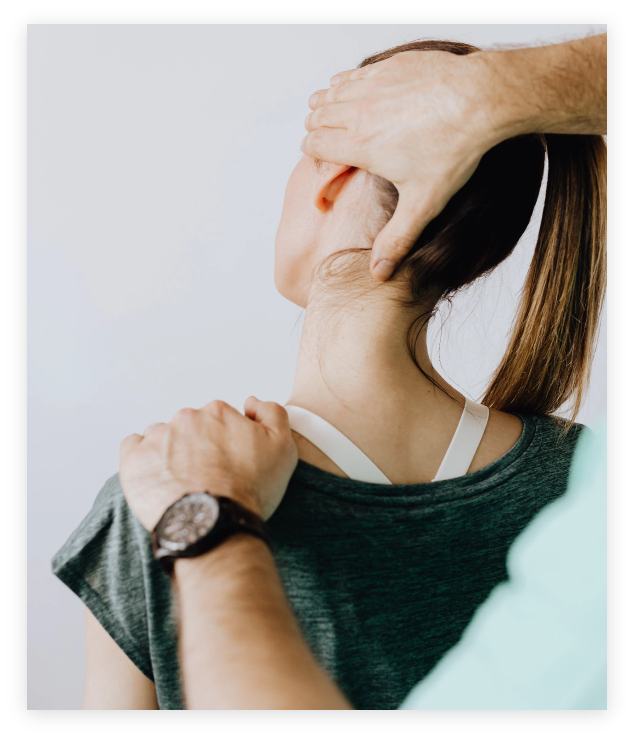

People with compression of the spinal cord in the neck (cervical stenosis) may benefit from a spine surgery called posterior cervical laminoplasty.
While cervical stenosis rarely resolves without spine surgery, posterior cervical laminoplasty is only one surgical option. We discuss the things you need to know about posterior cervical laminoplasty to make an informed decision.
What is a Posterior
Cervical Laminoplasty?
A posterior cervical laminoplasty is a spine surgery to increase the amount of space the spinal cord and spinal nerves have to travel through the spinal bones.“Posterior” means the surgeon approaches the spine through an incision in the back, rather than the front (anterior). “Cervical” indicates that the surgery will be performed on a spinal bone in the neck. “Laminoplasty” describes an alteration (“-plasty”) of the rear arch (lamina) of a spinal bone. In posterior cervical laminoplasty, the spine surgeon cuts part of the spinal bone to create a bridge that widens the spinal canal.


Am I a Candidate for a Posterior
Cervical Laminoplasty?
Only an experienced spine surgeon can determine if you are a candidate for posterior cervical laminoplasty; however, cervical laminoplasty is usually performed on people who have some degree of narrowing (stenosis) of the spinal canal. The best candidates for posterior cervical laminoplasty are those who have a neutral curvature of the neck or a lordosis (a “C” curve in the neck in which the “C” opens to the back). People with a cervical kyphosis (a “C” curve in the neck in which the “C” opens to the front) are generally poor candidates for posterior cervical laminoplasty. Your spine surgeon can use X-rays or other imaging studies to determine if you are a candidate for a posterior cervical laminoplasty.
What spinal conditions does posterior cervical laminoplasty treat?
• Cervical myelopathy
• Myeloradiculopathy secondary to ossification of the posterior longitudinal ligament
• Cervical spondylosis
• Congenital stenosis
• Multilevel disk herniation
• Traumatic central cord syndrome
Posterior cervical laminoplasty may be appropriate if your spinal bones are compressing your spinal cord, especially at more than one level of your spine. On the other hand, severe neck pain or an unstable cervical spine are reasons not to have posterior cervical laminoplasty.
Preparing for Your Procedure
As with any surgery, you will need to have a pre-op physical examination with your primary care doctor. You will likely undergo an ECG and bloodwork. Talk to your doctor about which medications should be continued and which should be held prior to surgery. Drugs that can thin the blood, like NSAIDs, should be stopped for several days to a week before surgery, for example. Some medications must be taken the morning of surgery with a very small amount of water, but for the most part, all medications are postponed until after the procedure, and you should not eat or drink anything after midnight the night before surgery. Your spine surgeon may need some additional imaging of your cervical spine prior to surgery (e.g., MRI of the spine).
The Posterior Cervical
Laminoplasty Procedure
- How It Works
Posterior cervical laminoplasty is performed with the patient lying prone or face down. This gives the surgical team access to the back of the neck. An incision is made down the center of the neck, and the spinal muscles are gently moved up and away from the spine. Once the spinal bones are visible, the lamina is cut. The lamina is the name given to the part of the spinal bone that surrounds the back of the spinal cord. The typical way in which the lamina is cut is to form a “door” or bridge. The lamina is cut all the way on one side of the spine, i.e., complete osteotomy, and partially cut on the other side to create a hinge of sorts. The critical goal of this procedure is to give the spinal cord and nerves more room within the spinal canal. The “door” may be kept open by using permanent sutures to hold the hinged lamina in place. In some cases, a posterior cervical laminoplasty is combined with an instrumentation fusion.
Posterior Cervical Laminoplasty and Fusion
Some patients’ conditions are best treated with posterior cervical laminoplasty and fusion. In posterior cervical laminoplasty and fusion, the lamina is partially cut on one side and completely cut on the other. The two cut ends of bone are then “fused” with hardware such as screws, rods, and plates. This fusion gives the cut spinal bone more stability and structural integrity. Posterior cervical laminoplasty and fusion may be useful for patients with cervical spondylotic myelopathy, for example.
Posterior Cervical Laminectomy vs Laminoplasty
The difference between laminectomy and laminoplasty can be found in the suffixes of each word. In surgical terms, an “-ectomy” is the removal of something from the body. For example, an appendectomy is the removal of the appendix. A “-plasty” means that the shape of something is changed. For example, a rhinoplasty (i.e., nose job) changes the shape of the nose. Thus, a posterior cervical laminectomy is the removal of a piece of spinal bone from the neck. A posterior cervical laminoplasty, on the other hand, is a surgery that changes the shape of a spinal bone in the neck.


Posterior Cervical Laminoplasty Recovery Time
Plan on spending one to two days in the hospital after your posterior cervical laminectomy. Your pain will be controlled with IV medications initially, and then oral medications before you are discharged. During this time, you will meet with a physical therapist and an occupational therapist who will encourage you to walk and perform daily activities safely.
During the first two weeks, you should hold your neck in a neutral position, i.e., looking straight ahead, no turning side to side or up and down. You will probably be asked to wear a neck brace or collar for two weeks after your posterior cervical laminectomy, which will help you maintain a neutral neck position. Keep in mind that you will not be able to drive a car during these first two weeks. Pain and discomfort should lessen over the first few days. In fact, most people only need opioid pills for the first five days after surgery. After that, acetaminophen (not NSAIDs) can be used to control the discomfort.
Your first follow-up appointment with your spine surgeon usually occurs two weeks after surgery. The two-week mark is a critical time in your recovery. At two weeks after posterior cervical laminectomy, you may be able to resume light activities, start a physical therapy program, remove the neck brace, and possibly return to work (if it does not require any physical labor). That being said, most patients can get back to most normal activities with three to six weeks after posterior cervical laminectomy. Full recovery, however, make take up to three months.
Life After Posterior Cervical Laminoplasty - What to Expect
Almost all patients enjoy several benefits after posterior cervical laminectomy. The spine surgery procedure stops cervical myelopathy from getting worse. In other words, if you notice symptoms that have been getting worse over time, posterior cervical laminectomy should stop that progression. Many patients also recover at least some function that was impaired before surgery, such as muscle weakness, balance and coordination issues, or incontinence. Unfortunately, some nerve and spinal cord damage may be permanent, so certain symptoms may remain after posterior cervical laminectomy. Neck and shoulder pain usually respond—at least partially and sometimes fully—to the treatment. Persistent neck pain may require a second spine surgery to correct, such as a fusion, if one was not performed during the laminectomy.
Ready to reclaim your life? Get in touch with Dr. Lanman Today.
FOLLOW US ON SOCIAL MEDIA | @ADRSPINE



